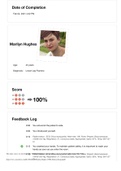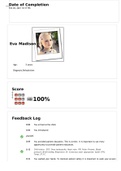RNSG 1261 (RNSG1261)
Lone Star College
Page 4 out of 45 results
Sort by
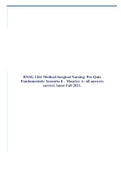
-
RNSG 1261 Medical-Surgical Nursing/ Pre-Quiz Fundamentals: Scenario 8 – Maurice A: all answers correct, latest Fall 2023.
- Exam (elaborations) • 5 pages • 2023
-
- $7.49
- + learn more
Pre-Quiz Fundamentals: Scenario 8 – Maurice A. 1. Diffusion of oxygen into the blood occurs in which structure located in the lungs? A. Carina B. Segmental bronchi C. Terminal bronchiole D. Alveoli 2. The normal respiratory rate for a healthy adult is: A. 6 to 10 breaths per minute. B. 10 to 16 breaths per minute. C. 12 to 20 breaths per minute. D. 18 to 26 breaths per minute. 3. A physician tells a patient that he is suffering from hypoxia. The patient asks the nurse what the term means. Whic...
Marilyn Hughes VSIM Medical-Surgical. (GRADED)
Eva Madison VSIM Pediatrics Age: 5 years Diagnosis: Dehydration
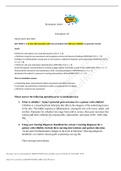
-
NUR 104, scenario 11 : Kyle Miller Case Study (answered), Pre-Quiz FUN: Scenario 11 – Kyle M,Simulation #1 Patient Name: Kyle Miller,Medication Log kyle, complete
- Package deal • 4 items • 2021
-
- $17.49
- + learn more
NUR 104, scenario 11 : Kyle Miller Case Study (answered), Pre-Quiz FUN: Scenario 11 – Kyle M,Simulation #1 Patient Name: Kyle Miller,Medication Log kyle, complete
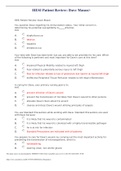
-
HESI Patient Review: Dave Mason> Answered all answers graded correct.
- Exam (elaborations) • 8 pages • 2021
-
- $23.49
- + learn more
HESI Patient Review: Dave Mason You question Dave regarding his immunization status. Your initial concern is determining his potential susceptibility to infection. Hint A. staphylococcus B. tetanus C. hepatitis D. streptococcus Your time with Dave has been brief, but you are able to set priorities for his care. Which of the following is pertinent and most important for Dave's care at this time? Hint A. Impaired Physical Mobility related to injured left thigh B. Fear related to potentially-serio...
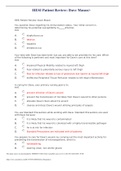
-
HESI Patient Review: Dave Mason> Answered all answers graded correct.
- Exam (elaborations) • 8 pages • 2021
-
- $22.49
- + learn more
HESI Patient Review: Dave Mason You question Dave regarding his immunization status. Your initial concern is determining his potential susceptibility to infection. Hint A. staphylococcus B. tetanus C. hepatitis D. streptococcus Your time with Dave has been brief, but you are able to set priorities for his care. Which of the following is pertinent and most important for Dave's care at this time? Hint A. Impaired Physical Mobility related to injured left thigh B. Fear related to potentially-serio...
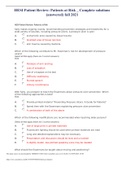
-
HESI Patient Review: Patients at Risk _ Complete solutions (answered) fall 2021
- Exam (elaborations) • 8 pages • 2021
-
- $24.49
- + learn more
HESI Patient Review: Patients at Risk Sally makes ongoing rounds, recommending prevention strategies and treatments for a wide variety of wounds, including pressure ulcers. A pressure ulcer is a/an: A. ecchymotic area caused by tissue trauma B. localized area of tissue necrosis C. skin trauma caused by bacteria Which of the following contribute to Mr. Esserman's risk for development of pressure ulcers? Select all that apply (there are 5 correct answers). Hint A. Paralysis of arm and leg B. Loss...
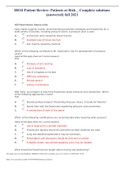
-
HESI Patient Review: Patients at Risk _ Complete solutions (answered) fall 2021
- Exam (elaborations) • 8 pages • 2021
-
- $23.49
- + learn more
HESI Patient Review: Patients at Risk Sally makes ongoing rounds, recommending prevention strategies and treatments for a wide variety of wounds, including pressure ulcers. A pressure ulcer is a/an: A. ecchymotic area caused by tissue trauma B. localized area of tissue necrosis C. skin trauma caused by bacteria Which of the following contribute to Mr. Esserman's risk for development of pressure ulcers? Select all that apply (there are 5 correct answers). Hint A. Paralysis of arm and leg B. Loss...

-
HESI Patient Review: Patients at Risk _ Complete solutions (answered) fall 2021
- Exam (elaborations) • 7 pages • 2021
-
- $8.49
- + learn more
HESI Patient Review: Patients at Risk _ Complete solutions (answered) fall 2021-Sally makes ongoing rounds, recommending prevention strategies and treatments for a wide variety of wounds, including pressure ulcers. A pressure ulcer is a/an: A. ecchymotic area caused by tissue trauma B. localized area of tissue necrosis C. skin trauma caused by bacteria Which of the following contribute to Mr. Esserman's risk for development of pressure ulcers? Select all that apply (there are 5 correct answers)...
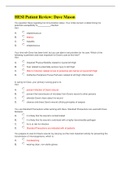
-
HESI Patient Review: Dave Mason> Answered all answers graded A.
- Exam (elaborations) • 7 pages • 2021
-
- $7.49
- + learn more
HESI Patient Review: Dave Mason> Answered all answers graded A.-You question Dave regarding his immunization status. Your initial concern is determining his potential susceptibility to infection. Hint A. staphylococcus B. tetanus C. hepatitis D. streptococcus Your time with Dave has been brief, but you are able to set priorities for his care. Which of the following is pertinent and most important for Dave's care at this time? Hint A. Impaired Physical Mobility related to injured left thigh B...

How did he do that? By selling his study resources on Stuvia. Try it yourself! Discover all about earning on Stuvia

